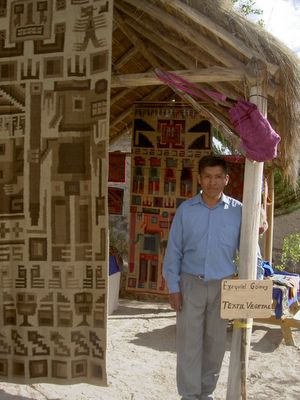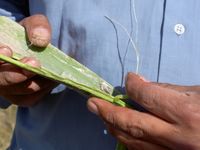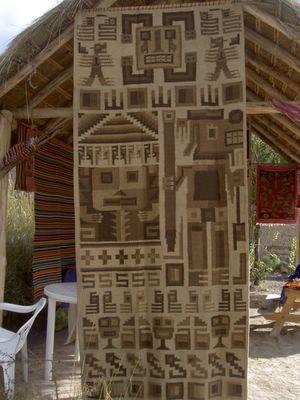Tom: Semana Santa takes place mostly at night; the candlelit processions, ornately decorated floats, elaborate street murals and massed chanting faithful all appear mainly at night. During the days the people of the Ayacucho region put on displays of the products of their quotidian labors. These fairs encompass agricultural products, livestock, traditional functional and artesanal crafts, music and dance. Today, we went to a fair that highlighted locally produced honey, luscious jams, idiosyncratic wines and liquors, fat and succulent cuy (guinea pig), highly detailed ceramics and colorful and exotic textiles.
During the course of our trip, I have been tempted by lots of gorgeous wall hangings, rugs and garments. I have not bought anything mainly because I have not wanted to carry anything along as we travel. I also am leery of returning to Florida with delicious llama or alpaca wool treats to feed the legions of the moths and other hungry critters who share our living space. Today, I found something I wanted and felt secure about bringing home.
The Conquistadors left Spain confident that they represented the pinnacle of world civilization. They confronted and destroyed a civilization that was equally certain of its’ being the acme of human achievement. Technology, disease, selfishness, arrogance and serendipity were among the factors that made the Spanish victory possible. When the Conquistadors made their sweep through the Incan empire they were faced with wonders and achievements that made their victories seem unlikely if not impossible. Indeed, the ease with which a huge, well organized and militaristic society was dismantled by a tiny number of men made it clear to the aggressors and the defeated that the Spanish triumph must be the will of God. The success of the Conquistadors was sped by the extraordinary Incan road system. One aspect of the road system that amazed the Spanish was suspension bridges that were far beyond anything that existed in Europe. Suspension bridges were to be one of the wonders of the industrial revolution. Steel cables made possible spans that were inconceivable previously. Four hundred years earlier the Incans made this leap without iron or steel. They hung spans high over impassable abysses containing churning rivers; some of these bridges lasted for centuries after their empire had been destroyed. These wonders of engineering hung upon cables fabricated from twisted fibers of a plant most of us think of only when wondering where tequila comes from, the agave plant.
Ezequiel Gomez is a weaver from Ayacucho.
He does not work in llama and alpaca wool as do the vast majority of his colleagues. He is weaving with agave fibers. These fibers are not attractive to insects, they are extremely durable and they are colored with slow fading vegetable dyes.
 |  |
The designs used in the piece which I purchased are derived from designs used by the Wari people, a predecessor of the Incans. It is thought that the Incans took many of their most successful ideas from the Wari.

I promised Ezequiel that I would put some pictures of him and his work on the web. I hope you like this Ezequiel.

No comments:
Post a Comment